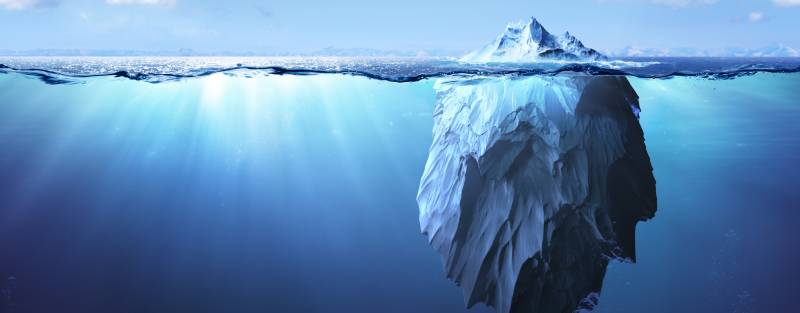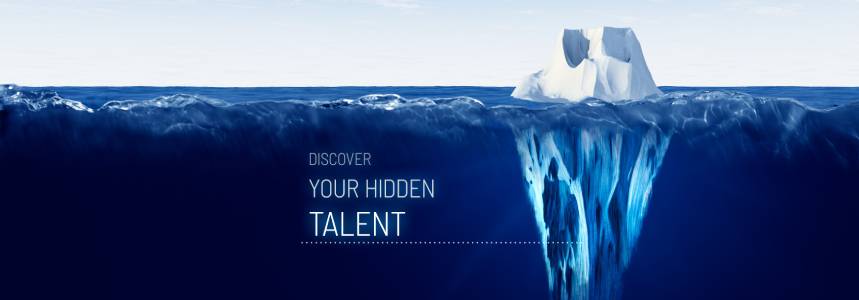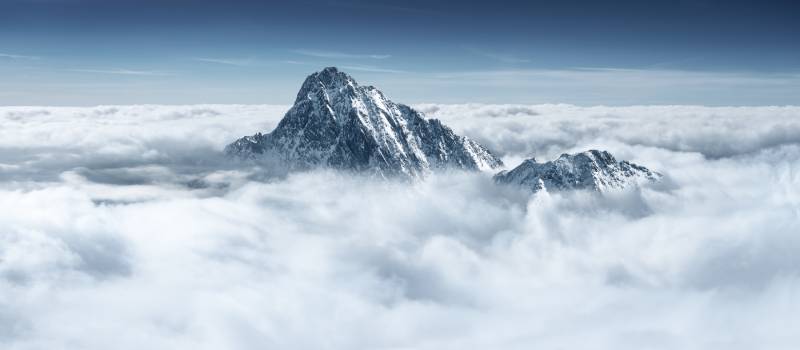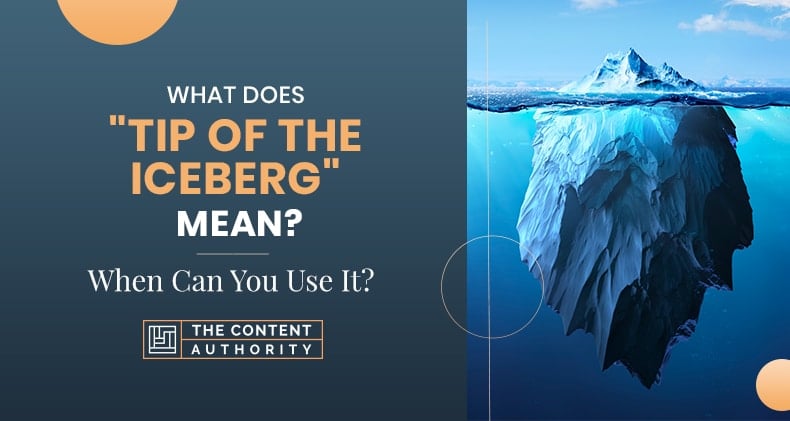Often, we find situations where we receive a small amount of information, and the rest is still unknown. But that small amount of information makes us imagine how big the situation is or could be.
The tip of the iceberg means that something is a small part of a bigger situation. Real icebergs inspired that phrase since only we can see the tip, but the larger part is below water, and we can’t see it.
Other synonyms of the definition of this phrase are:
- To only know very little of the issue in discussion.
- To not have the total scope of the problem.
- To underestimate a situation.
- There may be a more extensive, hidden problem.
Origin
Remember The Titanic? The big ship that sank in the ocean after hitting an iceberg whose bigger mass was not visible from above the water? That is exactly the origin of this phrase. Follow me on this, please:
Icebergs are well known for being much larger beneath the water than above their surface. This affects the situation for ships in their attempts to get to paths around them. That bigger mass is not visible and may hurt the ship and cause it great damage or even to sink. This phrase is now used for things that only give a small percentage of a situation and may have hidden issues.
After knowing all this, the idiom is pretty relatable to a visual image of an actual Iceberg. Imagine a block of big, rock-hard ice, but only the top part is visible, and the rest is not because it is underwater. Got it? Okay. Now let’s imagine for a second that we are sailing in a boat, and we see from not very far, a small pointy figure above water and everything around it is dark or covered with icy or snowy water. As you get closer to it, you don’t see the danger. But as soon as you get to some specific distance, depending on the size, you won’t even get to the small part because the big one underwater would have stopped you or injured your ship. Very badly.

Examples Of The Phrase In A Sentence
Now I will show you some examples of how to use this phrase in different scenarios and conversations so that you get a clearer picture of how to put it in place and use it. But remember that these examples are that, examples if you find it like an actual life experience is a coincidence.
- Although antibiotics resistance, related to frequent unprescribed use, is a serious national issue in healthcare, that is only the tip of the iceberg. There is a lot of health education left to do.
- Even if you don’t believe me, all these short stories were the tip of the iceberg. After that, the real-life stories began.
- There is more than meets the eye. All that bad behavior was the tip of the iceberg. After that, the behavior got worse, and I was not able to handle it anymore.
- More than 100,000 tourists are set to arrive in our country this summer, and that is the tip of the iceberg. have half a million by the end of the year.
- All that partying reported was the tip of the iceberg. There was more after the concert was over.
- This whole book is the tip of the iceberg. After we finish, there is a quiz waiting for you.
- If you think I am done, let me tell you that this is the tip of the iceberg. Now I’m going to do some dancing.
- The employee issues in this enterprise are the tip of the iceberg. There is a lot of work to do from Human Resources.
- The things you know about the situations between your cousin and your brother are the tip of the iceberg. Period. There is more, but you don’t need to know right now.
- I do not have the authority to discuss that subject. What you know is the tip of the iceberg, and that will suffice for now.
- I had wished that in their case, that loud discussion was not the tip of an iceberg, but I was very wrong. There was a lot more going on.
- These corruption scandals are the tip of the iceberg. More investigations are going on. A lot of people are going down. It was about time someone does something about it.
- All you know about the singer’s personal life is the tip of the iceberg. His life is far more complex than we can think.
- What you saw is the tip of the iceberg. This has been going on for a lot of time. And right now, they don’t care.
- Her talent is being discovered, and she can do way more than this. We only see the tip of the iceberg. Wait and see what she is capable of doing.
- The amount of information I’m giving you is just the beginning. It’s the tip of the iceberg. The rest I will give to you when you are ready.
- Modern leaders are changing the world. Facebook, Tesla, Apple are the tip of the iceberg. The game is changing, and so are we. We have to be ready.
- Modern computers have become more and more powerful. These new small artifacts for tracking animals are the tip of the iceberg. Maybe in the feature, we will have our permanent tracking device.
A Little Bit About Icebergs

For a better understanding of the phrase, it is fair to know a little about icebergs in general. Not too much, enough to use them as a metaphor in our daily conversations
We see icebergs only in white because of the snow covering them, at least I am. But in fact, icebergs can be blue, green, yellow, striped, rainbow-colored, or even. Black. This last one is due to sediment.
Icebergs can be classified by their shapes. The two basic forms of them are tabular and non-tabular.
Tabular Icebergs
They are also known as Ice land. The largest icebergs in the world form this way.
Non-Tabular Icebergs
They can have different shapes such as:
- Wedge: is an iceberg with a slope on one side and a steep edge on the opposite.
- Dome: A rounded top iceberg.
- Dry-Dock: This one has become a channel or a slot because of an erosion process.
- Pinnacle: it has one or more spires.
- Blocky: An iceberg with a flat top and steep, vertical sides.
When Are You Going To Hear This Phrase?
I am not a fortune teller, but I can assure you that in many situations, you will find this phrase useful. For example, when people talk about their culture and they are showing you “the tip of the iceberg,” a small summary of what they most remember. Holidays, traditions, values, music, most popular artists and athletes and political situations, current or past, etc.
I’m sure if later on you do some extra digging, you will find more details.
Another good example is when we talk about our family. And if it is a big one, then the iceberg gets bigger. We start talking about the first years of our life, growing up, how we managed to get by, how our family behaved. It depends a lot on experience, but it applies.
“The tip of the iceberg” can also describe negative situations. For example, when we confide a problem to someone, and we tell one of the parts that seem bad but not as much as the rest. It applies most when we don’t want to overshare or we don’t have a lot of time to continue talking. In any case, it still applies.
Artists sometimes use this term when they release material and promise more to come. It is used to create an expectation for fans and new followers.
And speaking of art, the band “New Found Glory” released an album called “the tip of the iceberg.” It was a six song EP with tracks no longer than two and a half minutes. I don’t know about you, but they chose the best name for it.

Conclusion
So, to conclude, we saw different examples of how to use the phrase” tip of the iceberg” and when to use it. There are many more uses than we are aware of, but it is good to see the different uses and how to apply them. That makes our vocabulary richer, and we can illustrate more our ideas.
Try to use it as much as you can and then you will find yourself using it without noticing.
And, to put it to good use, let’s finish off by saying that all this information is the tip of the iceberg in this quest. Remember to find new ways to use this idiom to enrich your vocabulary and have more to say with fewer words.
Shawn Manaher is the founder and CEO of The Content Authority. He’s one part content manager, one part writing ninja organizer, and two parts leader of top content creators. You don’t even want to know what he calls pancakes.

